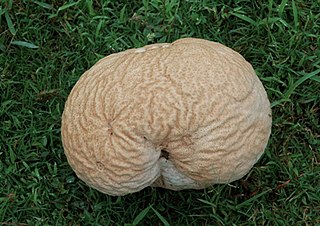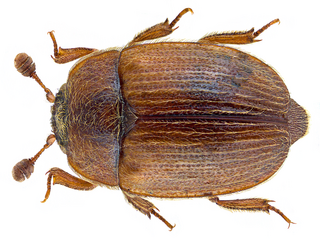
Calvatia is a genus of puffball mushrooms that includes the spectacular giant puffball C. gigantea. It was formerly classified within the now-obsolete order Lycoperdales, which, following a restructuring of fungal taxonomy brought about by molecular phylogeny, has been split; the puffballs, Calvatia spp. are now placed in the family Agaricaceae of the order Agaricales.

The Polyporaceae are a family of poroid fungi belonging to the Basidiomycota. The flesh of their fruit bodies varies from soft to very tough. Most members of this family have their hymenium in vertical pores on the underside of the caps, but some of them have gills or gill-like structures. Many species are brackets, but others have a definite stipe – for example, Polyporus badius.

The rusty pitohui is a species of bird in the family Pachycephalidae. It is found throughout the lowlands of the Aru Islands and New Guinea.

The palm weevil Rhynchophorus ferrugineus is one of two species of snout beetle known as the red palm weevil, Asian palm weevil or sago palm weevil. The adult beetles are relatively large, ranging between 2 and 4 centimetres long, and are usually a rusty red colour—but many colour variants exist and have often been classified as different species. Weevil larvae can excavate holes in the trunks of palm trees up to 1 metre (3.3 ft) long, thereby weakening and eventually killing the host plant. As a result, the weevil is considered a major pest in palm plantations, including the coconut palm, date palm and oil palm.

Irpex lacteus is a common crust fungus distributed throughout temperate areas of the world. It is the type of the genus Irpex. Irpex lacteus is considered a polypore, but depending on growth conditions it can also produce a hydnoid hymenophore. Due to this variability and abundance of the species it has been described as a new species to science numerous times and subsequently has an extensive synonymy. The complete genome sequence of Irpex lacteus was reported in 2017.

The ferruginous-backed antbird is a species of passerine bird in the family Thamnophilidae. It inhabits the Guyanas and the northern Amazon Basin. Its natural habitat is subtropical or tropical moist lowland forests.

Cretornis is a pterosaur genus from the late Cretaceous period of what is now the Jizera Formation in the Czech Republic, dating to about 92 million years ago. It only contains a single species, Cretornis hlavaci.

Rollinia is a genus of plants in the family Annonaceae. While it is widely recognised as a distinct genus a monograph published in 2006 advocates its inclusion in Annona, which also contains custard apples and soursops.

Guatteria is a genus of flowering plants in the family Annonaceae. It is the largest genus in the family in South America, and the dominant genus in mature forest. The fruits are berries, borne in clusters on short stalks.

Bolbitius is a genus of small mushrooms in the family Bolbitiaceae.

Xerocomus subtomentosus, commonly known as suede bolete, brown and yellow bolete , boring brown bolete or yellow-cracked bolete, is a species of bolete fungus in the family Boletaceae. The fungus was initially described by Carl Linnaeus in 1753 and known for many years as Boletus subtomentosus. It is edible, though not as highly regarded as other bolete mushrooms.

Ozothamnus ferrugineus, commonly known as tree everlasting, is a member of the genus Ozothamnus, of the Asteraceae family – one of the largest families of flowering plants in Australia. Native to the Australian states of New South Wales, Victoria, South Australia, and Tasmania, it forms an erect shrub or small tree between 2 and 3 metres in height.

Beesoniidae is a family of scale insects commonly known as beesoniids. They typically cause galls on their plant hosts. Members of this family mostly come from southern Asia. The family name comes from the type genus Beesonia which is named after the entomologist C.F.C. Beeson who obtained the specimens from which they were described and named.

The palm weevil Rhynchophorus vulneratus is one of two species of snout beetle known as the red palm weevil, Asian palm weevil, or Sago palm weevil. The adult beetles are relatively large, ranging between 2 and 4 centimetres long, and vary from a rusty red colour to almost entirely black; many colour variants exist and have led to considerable confusion with other species. Weevil larvae of these species can excavate holes in the trunk of a palm tree up to 1 metre long, thereby weakening and eventually killing the host plant. As a result, these weevils are considered major pests in palm plantations, including the coconut palm, date palm and oil palm.

Actinoplanes is a genus in the family Micromonosporaceae. They have aerial mycelia and spherical, motile spores. Actinoplanes species produce the pharmaceutically important compounds valienamine, teicoplanin, and ramoplanin.
Siphula is a genus of lichenized fungi in the Icmadophilaceae family. The widespread genus contains about 33 species. Siphula was circumscribed by Swedish mycologist Elias Fries in 1831.

Rhynchophorus, or common name palm weevils, is a genus of beetles in the weevil family, Curculionidae. Palm weevils are major pests of various trees in the family Arecaceae throughout the tropics including: coconut, Areca catechu, species of the genus Phoenix, and Metroxylon sagu. Two species are invasive pests outside their native ranges, Rhynchophorus ferrugineus and Rhynchophorus palmarum.

Tylopilus ferrugineus is a bolete fungus in the family Boletaceae native to North America. Originally described by Charles Christopher Frost in 1874 as Boletus ferrugineus, it was placed in the genus Tylopilus by Rolf Singer in 1947.

Pocadius is a genus of sap-feeding beetles in the family Nitidulidae. There are about nine described species in Pocadius.
Dothidea is a genus of fungi belonging to the family Dothideaceae. The genus was first described in 1818 by Elias Magnus Fries. The type species is Dothidea sambuci.


















